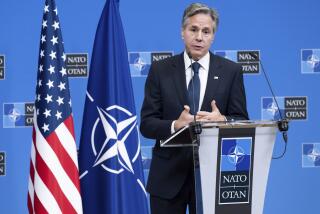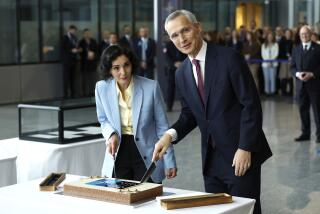Facing Reality on NATO Security : Token Political Fixes Can’t Balance Soviet Conventional Might
- Share via
As the United States looks toward the possibility of concluding a historic agreement with the Soviet Union on intermediate-range nuclear missiles, it becomes even more vital to take seriously the whole security equation in Europe, including the status of conventional forces.
Some of Moscow’s statements over the past year suggest consideration of significant changes in Soviet military doctrine. Included in such statements is an apparent Soviet willingness to reduce their overwhelming conventional military presence in Europe in order to allay long-standing Western security concerns. As welcome as these statements are, they raise very real questions for the free world. Are the Soviets serious this time and, if so, how should the United States and its European allies proceed in the field of conventional arms reduction?
The Soviet Union’s capacity for taking the high road in its public rhetoric is well known. But NATO security policy must deal with Soviet action and real capabilities, not self-proclaimed intentions. And there is nothing in Soviet actions thus far to suggest that their supposed willingness to reduce their conventional forces in Europe has been translated into action. On the contrary, they are maintaining the pace of their modernization program, fielding conventional weapons and formations with formidable offensive potential.
These new systems are being added to current inventories, not merely replacing older weapons as is the normal case in the West. Even as they talk about dramatic reductions, the Soviets are modernizing and expanding their preponderance of power over NATO in every significant category of conventional forces. The Warsaw Pact has over twice as many armored vehicles, artillery and combat aircraft as NATO. In fact, by one illustrative measure of combat capability that takes into account both quantity and quality of forces, the Warsaw Pact’s advantage over NATO in ground-force combat power in place has increased from around 1.5-to-1 in 1965 to more than 2.2-to-1 today. On the basis of Soviet actions to date, then, there is no reason to believe that they take their own rhetoric seriously.
But despite this evidence of real Soviet intentions, what if Soviet pronouncements portend an actual change in their future ambitions? What should our approach to the conventional force balance be?
First of all, NATO policy-makers must address the security equation based on reality. The reality is that NATO conventional force improvements are essential to redress the current conventional imbalance. As NATO prepares for new conventional arms talks with the East, this must be our first consideration. Though Soviet statements have been characterized as demonstrating a willingness to reduce Soviet conventional forces, the actual words of these statements call for reductions of Warsaw Pact and NATO forces--forces the Soviets incorrectly assess to be at “rough parity.”
Conventional force reductions could increase stabililty in Europe, but only if the reductions are highly asymmetrical, with very much larger Soviet cuts than Western reductions. Given current Warsaw Pact force levels, massive reductions of Soviet offensive ground forces in Eastern Europe must be made just to create a balance between Pact and NATO standing forces.
In fact, the alliance is not only vastly outnumbered in deployed forces, but NATO also is at a perhaps more important disadvantage in the capability to generate adequately trained and equipped reserves quickly to stop a Warsaw Pact breakthrough along the East-West border. While NATO’s current forces are highly capable, particularly opposite the largest Warsaw Pact concentrations, there are simply not enough of them. And a sufficiently large pool of trained reservists, together with the division formations and strategic air and sea lift needed to bring these men and equipment together for combat, simply does not exist.
Given military and geographic realities then, the West would be foolish to put its hopes for improving conventional stability in Europe on arms control. Unilateral NATO action to improve and rationalize its defense is the only dependable path to stable security. A negotiated approach to eliminate the conventional imbalance may complement NATO’s defense improvement efforts, and in this way further enhance European security.
Moreover, unless NATO’s agreed modernization program is carried out and unless even more imaginative defense improvements are implemented, there is no reason to expect agreements from the East that would add up to greater security for Europe. If we want the Soviets to take our conventional arms control initiatives seriously, we have to show them that we take their conventional buildup and our defense seriously.
This means resisting the temptation to accept token political fixes--such as an interim freeze at unequal levels, or reductions insufficient to offset the Warsaw Pact’s mobilization and reinforcement advantages--in the hopes of gaining more favorable outcomes in later “phases.” This means holding fast to rigorous requirements reflecting the real European security requirements of today.
More to Read
Sign up for Essential California
The most important California stories and recommendations in your inbox every morning.
You may occasionally receive promotional content from the Los Angeles Times.










